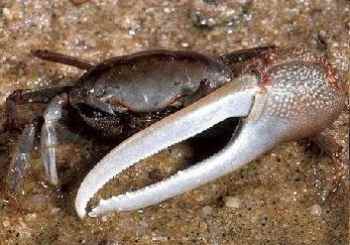Mangrove
The Crab and The Tiger
Living Planet
Now normally, plants access oxygen through their roots from tiny pockets of air in the soil. But in the sticky ooze of the Sunderbans, these pockets are virtually non-existent. But then, the mangrove is a pretty special plant.
You see, all of these spikes sticking out of the soil here are roots, and they act a bit like snorkels, sucking in oxygen out of the air when the plant can’t get it out of this thick mud. But then, the mangrove doesn’t just rely on its snorkels. There is something else going on here, something you can only appreciate at low tide.
Fiddler Crabs

Millions of crabs! Leaf-eating crabs and fiddler crabs.
They’re called fiddler crabs because they have this vastly-enlarged front claw. And when they are feeding, it looks like they’re playing the fiddle. They also wave them at any adversaries in a relative show of size and strength. In fact, when they are fully grown, that claw can represent 65% of the crab’s bodyweight – quite an investment for something to wave around at your enemies. These fiddlers are displaying to defend their territories. And their most valuable real estate is underground.
This little fiddler crab is excavating mud to create a burrow. When he’s finished, it’s going to be more than half a metre deep. His burrow gives him somewhere to hide from predators, like this stork. And when the tide comes in, from predatory fish.
These Leaf-eaters live in communal burrows, and together, their tunnels form an underground labyrinth. All of these burrows are vital for the mangrove. At low tide, they channel an air supply through the mud, direct to the roots. And it’s not just oxygen. The crabs even supply the trees with food. The first ingredient is all those smelly bacteria.
Look really carefully, and you can see this crab feeding. It’s picking up particles of soil and passing them to its mandibles. When it gets enough, it forms them into a ball, and it gradually removes all of the organic material, detritus and bacteria, and then it discards the ball. And you can see those that it’s processed lying on the surface here. And if the crabs didn’t do this, this mud wouldn’t be very nice – a nasty, sulphurous ooze.
Racing against the tide, this fiddler crab is taking bacteria-rich mud back to his burrow. Here, he’ll recycle it and release nutrients for the roots of the mangrove.
Sunderbans
Further up the beach, this leaf-eater is also working hard to gather his food before the tide steals it. These crabs collect a staggering 80% of the leaves that fall here in the Sundarbans and they store them at the bottom of their burrows. Where they, too, will essentially fertilise the mangrove. But best of all, the burrows even help control the saltiness of the swamp.
When the tide comes in, toxic seawater flows into the burrows and mixes with fresh water. And this allows the mangrove to expend less of its energy excreting salt, and more on actually growing.
Without these burrows, the Sunderbans simply couldn’t survive. Together, the crabs make a vast network – a sort of Sunderbans tube system.
The scale of the tube system is unbelievable. Just one square metre can have 300 tunnels. Crabs are ecosystem engineers. Without the many millions of them, living in this mangrove, the Sunderbans simply couldn’t work. That’s why the tiger needs the crab.
So the Tiger needs the crab. But it’s more magical than that. And there’s an even more unusual relationship… One that protects the Sunderbans from a lethal threat. Thanks to the crabs gardening the mangroves, the Sunderbans support some large herbivores. But too many eating too much would soon damage the forest, so it needs protection.
The monkeys have sounded a warning. This family of chital deer won’t be staying much longer It’s the very presence of these terrifying predators that protects the Sundarbans.
You see, in any ecosystem, top predators exert what we call “an ecology of fear”. And this influences the behaviour and movement of their prey. Here, that may be monkeys, or deer, or humans. In the Sunderbans the Tigers keep large numbers of people out of the forest, and they also keep all the herbivores on the move, so they don’t damage the trees. So, anyway, the tiger needs the crab to help build this place, but then the crab needs the tiger to help protect it. You’ve got to admit, that’s pretty neat.
And the result is this – the largest mangrove forest in the world! This mangrove ecosystem is dependent on a complex web of relationships between species as diverse as crabs and tigers to make it functional. But surprisingly, these connections don’t end here, because what happens on the coast, where the river meets the sea, actually has a profound effect on what happens out there.
